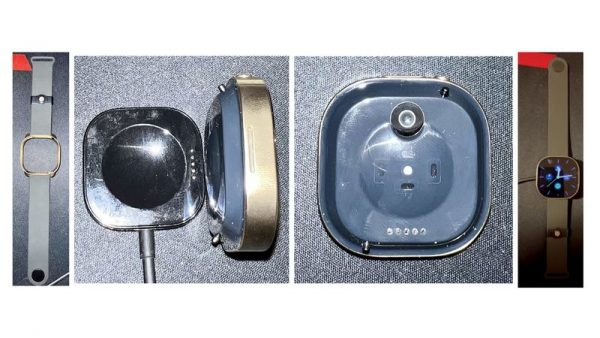Meta Shelves Its Smartwatch Project
A Bloomberg report states that Meta has shelved its project on a dual-camera smartwatch. However, work continues on its other metaverse wrist input devices.
Rumors about Meta’s smartwatch project have been hovering about for the past year. The smartwatch was meant to function with or without smartphone connectivity and it could also be used as an input device for virtual reality and augmented reality headsets.

Bloomberg now reports that Meta has discontinued work on the “Milan” smartwatch which has two built-in cameras including a 5-megapixel lens on the smartwatch prototype which records in the direction of the wearer, and a 12-megapixel lens that is positioned on the backside of the smartwatch against the wrist of the wearer. The watch is detachable from the wristband upon which the backside can be used as a camera. This description is based on images seen by Bloomberg.
The smartwatch device has been under development for at least two years and contained a number of features that you’d find in other smartwatches such as music playback, messaging, and activity tracking. A prototype of the smartwatch featured dual cameras which is a major market differentiator from some of the top smartwatch devices such as the Apple Watch.
The second camera of the smartwatch was designed to enable users to detach the watch face from its strap for quick photo snaps. However, the inclusion of the camera created problems with another feature of the smartwatch that translates the nerve signals from the wrist into digital commands. Meta is reportedly quite keen on incorporating this technical ability, which is called electromyography, into the smartwatch.
Meta says electromyography is critical in enabling the use of a person’s hands as a “controller” for other devices, including those that are key to the metaverse. It allows for the decoding and translation of the actions that a user has already decided to perform into digital commands for the device.
Smartwatches are in the sights of top Meta executives as part of their metaverse vision. The sensors in wrist-worn devices could be used to control users’ own avatars or interact with the objects seen via AR glasses.
While the wristwatch has been shelved aside, Meta is still pouring effort into the development of other wrist-worn devices.
Meta employees who were working on the now discontinued smartwatch were informed this week that the company is no longer planning to take the device into production. The smartwatch initially had a release date of spring 2023 and would have retailed at a price point of about $349.
The scrapping of the smartwatch is seen as part of Meta’s recent decision to cut down on costs on some of its key metaverse investments such as the development of its Augmented Reality glasses.
During an earnings call in April this year, company executives said annual expenses would go down by $3 billion this year as a result of a broader business slowdown. The cost-cutting has also forced the company to freeze hiring in some divisions. The filling up of some management roles has been paused or slowed down in recent weeks.
The general cost-cutting at Meta will see the company prioritize some of its projects and efforts while slowing down or putting a freeze on others, Zuckerberg had told investors.
Bloomberg also reported that Meta told its employees that its much-anticipated AR glasses that have been under development for several years won’t be commercialized. Instead, the company will produce a version just for demonstration purposes. Meanwhile, Meta is shifting its focus to the successor of those AR glasses which is codenamed Artemis and is expected to be released in 2026.
Meta also made a strategy shift in its Portal video calling device which will now target business customers and not consumers as initially envisioned.
Some of the features that Meta developed for the now discontinued dual-camera smartwatch will most likely re-emerge in the company’s future products. These features include: –
- Removable watch face with a gold-colored casing: There are two buttons on the side of the casing; one button is long and “pill-shaped” while the other is a small circular control.
- Built-in dual cameras: One is a 5-megapixel camera positioned on the front part of the watch face while the other is a 12-megapixel camera positioned on the backside of the smartwatch and which is used when the face is detached.
- Provides GPS, cellular, and WiFi connectivity through eSIM
- Supports different kinds of apps including Instagram Stories, WhatsApp, Spotify and apps for photo gallery, workouts, heart rate monitoring, settings, calendar, and breathing.
- Gives up to 18 hours of battery life
There is also a lock screen and notification center on the smartwatch. However, it lacks a built-in App Store so users will have to manage features and apps from their Facebook account.
The device would also allow wearers to post details of their fitness activities along with achievements directly on Facebook and Instagram.
An image of the smartwatch was first spotted inside a Meta app for managing its Ray-Ban Stories smartglasses. Some other details of the smartwatch were also reported by The Verge.
The smartwatch was reportedly being built by the Reality Labs division, the branch of the company that is charged with pursuing Meta’s long-range metaverse vision. Reality Labs is one of the divisions that has been affected by Meta’s recent expenditure cutbacks.
https://virtualrealitytimes.com/2022/06/11/meta-shelves-its-smartwatch-project/https://virtualrealitytimes.com/wp-content/uploads/2022/06/Development-of-dual-camera-smart-watch-paused-600x338.jpghttps://virtualrealitytimes.com/wp-content/uploads/2022/06/Development-of-dual-camera-smart-watch-paused-150x90.jpgBusinessMetaA Bloomberg report states that Meta has shelved its project on a dual-camera smartwatch. However, work continues on its other metaverse wrist input devices. Rumors about Meta’s smartwatch project have been hovering about for the past year. The smartwatch was meant to function with or without smartphone connectivity and it...Kristin HummelKristin Hummel[email protected]AuthorVirtual Reality Times - Metaverse & VR
